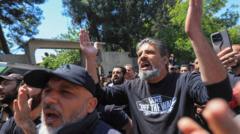The Druze community in Syria is facing escalating fears amid rising sectarian violence, leading many to question their safety and position in the nation. Recently, incidents of violence against Druze individuals have sparked widespread panic, igniting concerns of isolation in a landscape deeply altered by the ongoing conflict.
Lama al-Hassanieh, a resident of Ashrafiyat Sahnaya, recalls a night when gunfire erupted near her home. Locking herself in a bathroom, she heard fighters outside chanting threats against the Druze. This sentiment is echoed throughout the community, as the Druze have historically occupied a delicate status in Syria's multifaceted sociopolitical landscape.
Traditionally aligned with state powers under Bashar al-Assad—believing that loyalty would shield them from the sectarian violence plaguing other regions—Druze individuals now find themselves in precarious straits, fearing that their affiliation might not offer protection any longer. The recent unrest, particularly after a controversial audio recording purportedly involving a Druze religious leader, ignited a series of violent clashes, resulting in at least 137 deaths, including both civilians and armed forces.
Students like Lama Zahereddine have been caught in the crossfire, forced to flee their homes as violent assaults escalated. Reports of beatings and targeted attacks on Druze students in universities exacerbate the community’s distress, leaving many feeling vulnerable and abandoned by the state they had once seen as a safeguard.
Despite claims from the Syrian government that the violence stemmed from unaffiliated outlaw factions, those sentiments do little to alleviate the anxieties of the Druze. As Lama al-Hassanieh expresses, the once-familiar face of fellow citizens and comrades is shifting, causing a rift of trust in a community grappling with the question: "Who can we rely on now?"
With significant attacks subsiding, relief is mixed with anxiety; trust in government assurances about safety is waning. During violent incidents, even Israel carried out strikes, claiming to target groups attacking Druze individuals, demonstrating a regional entanglement in the ongoing crisis.
As static insecurity reigns, the atmosphere in Ashrafiyat Sahnaya remains cautious. Many members of the Druze community are calling for accountability against those who have perpetuated violence, reiterating that they do not wish to be seen as a minority but as a legitimate part of Syrian society entitled to equal rights and protections.
In this time of uncertainty, the Druze are left to ponder their identity, safety, and the future of their community within a changing Syrian landscape. The persistent fear of persecution, coupled with growing insecurity, continues to define their existence amid a nation in turmoil.




















